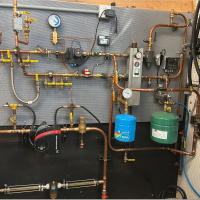Best Of
Re: Oil to Gas conversion steps
Right, it very well may be complete boiler replacement rather than just the fuel gun. In NYC especially, prepare to pay a considerable sum in D.O.B. permit, fees, and filing. Your NYC licensed master plumber will be familiar with the procedure. I strongly suggest referencing the Find a Contractor section on this site.
It really depends on the inspector that shows up and what his pet peeves are. Be prepared for the inspector to need access to all areas of the basement. If you look at it as wanting to "do things right," by your home or building, you'll have peace of mind in the years ahead.
I see real estate closings held up all the time by lack of proper permits, outstanding violations, and no C of O.
Mad Dog
Re: Best Material to Use for Drainpipes in Residential Homes.
Agreed, with the proviso that poured seals on CI are most likely longer lasting than elastomeric connectors.
Re: Best Material to Use for Drainpipes in Residential Homes.
once the coating inside breaks down , iron pipe will corrode, develop scale and rot through
Aggressive. Low ph water can do that.
All piping materials have pros and cons.
The OP needs to define “best”😉
 hot_rod
hot_rod
Re: Oil to Gas conversion steps
This sounds like it might be a nyc specific question and things can be different there.
Re: Oil to Gas conversion steps
Presumably you are having a pro. do the conversion, and they have determined that the boiler can, in fact, be converted and that the chimney is suitable for gas? If so, let the pro. handle it all…
Generally a building inspector won't look at things which weren't touched or affected — but they can if so minded, so it pays to be nice to them.
Re: Undersized waste line
sounds like they tied into a 2” drain or vent pipe?
Is it clogging up, or why the concern? It needs to be 3” for a toilet, by code.
 hot_rod
hot_rod
Re: Best Material to Use for Drainpipes in Residential Homes.
if you're putting string down the drain it is likely to get tangled on something regardless of material.
Re: Best Material to Use for Drainpipes in Residential Homes.
No-Hub cast iron has always been the top shelf material here and of course, the plumber installing it has to be of equal quailty as well.
No-Hub cast iron drains, ABS vents. For commercial work or houses over two stories, the materials had to be all metal, so we used DWV copper for the vents.
In the beginning, we used a chain snapper to cut the cast iron, but then transitioned to a chop saw as it was faster and the cuts more accurate.
Re: Boiler
The best one is the one that’s installed and maintained properly by a competent hydronic pro: he’s 95% of the equation.
Find the best hydronic contractor and go with his recommendation.
However, the Buderus is the best cast iron oil boiler.
 Ironman
Ironman
Re: Is the circulator pump too powerful?
I suspect that a Flo Control (check) valve would solve this. I Imagine Zones 3 and 4 are next to each other?
Really, each zone should have it's own flow control valve.


